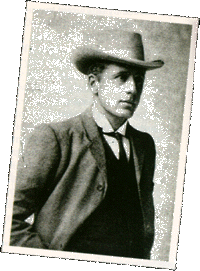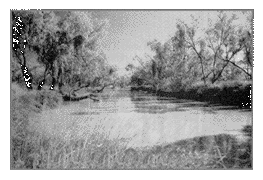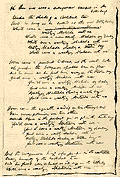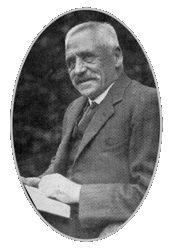Roger Clarke's Web-Site
© Xamax Consultancy Pty Ltd, 1995-2024

Infrastructure
& Privacy
Matilda
Roger Clarke's Web-Site© Xamax Consultancy Pty Ltd, 1995-2024 |

|
|||||
| HOME | eBusiness |
Information Infrastructure |
Dataveillance & Privacy |
Identity Matters | Other Topics | |
| What's New |
Waltzing Matilda | Advanced Site-Search | ||||
© Xamax Consultancy Pty Ltd, 1995-2001
This document is at http://www.rogerclarke.com/WM/Banjo.html
It is a page within Roger Clarke's Waltzing Matilda site
Banjo Paterson was an average solicitor, but a much-loved poet. Great literature his works may not be, but they captured much about the life of the time.

Paterson worked in Sydney, but was about 1,500 km (950 miles) north, in central Queensland, when he wrote the song. In January 1895, he was travelling with his fiancee Sarah Riley (the Irish element in Australian social history is pretty noticeable at times!). They stayed for a few weeks at Dagworth Station, a 100,000 hectare (400 square mile) property near Winton. There he met an old schoolmate of Sarah's, Christina Macpherson, whose brother Bob managed the station.
At some stage during the rainy visit (it was the middle of 'the Wet'), Christina played a version of a tune called 'Craigeelee'. Some renditions say that she played it on an instrument called an autoharp, but Richard Magoffin quotes Paterson himself to the effect that it was in fact played on a zither. Unfortunately the term zither is used, and has long been used, to refer to many of a large family of stringed instruments (hence, for example, it could have been an autoharp - which is a fairly specific descriptor - but Paterson could have used the generic sense of 'zither' to refer to it). Here's one history of the zither.
The main page contains some second-hand information and some interpretive comments on the tune.

Over dinner at the station, Paterson first heard the experssion 'waltzing matilda'. Soon afterwards, Bob Macpherson took Paterson to Combo Waterhole nearby, where they stumbled across the skin of a newly killed sheep.
Another formative influence may have been a recent incident on the property, that must have become known to Paterson. This was the period during which unionisation emerged in Australia, and the sheep-shearers were fighting the graziers for better wages and conditions. On 1 September 1894, a mere four months earlier, shearers had set the Dagworth woolshed ablaze, cremating a hundred sheep. Macpherson and three police troopers had pursued them. One had shot himself (out of remorse at killing sheep?? More likely, to avoid capture). The man's name was Hoffmeister.
So it's to be presumed that Paterson linked a dead sheep at the billabong, presumably killed by a swagman, with some details from the pursuit and presumed defiance of a shearer with a German name. (Sort-of kills the romance, dunnit?!).
One aspect that seems odd is that the song gives the impression of remarkable sympathy for the plight of the working class in the face of the power of the land-owners and their friends the police. Did Bob and Christina Macpherson really enjoy hosting someone who wrote songs that romanticised their opponents??
This explanation, which may have been originated by Magoffin, is not without its critics. I'm told by a correspondent that, in Stuart Svensen's self-published book - 'Industrial War: The great strikes 1890-94' published in 1995 (RAM Press - self published), in a chapter on the origins of Waltzing Matilda, Svenson favours an older theory: "A squatter and three policemen are on a ride; they spot a swagman who has stolen a sheep; the swagman escapes arrest by diving into a waterhole. End of story". Svenson gives his reasons in the book, which comes down to 'logical consistency and parsimony'. Svensen also wrote 'The Shearers' War. The Story of the 1891 Shearers' Strike' (University of Queensland Press, 1989). Svenson's anti-romantic version appears to be supported by no actual evidence.

Whatever the strains [sic] that may have emerged between hosts and guests, Christina wrote up the score for the song, the original words were revised a couple of times to improve its 'feel' and singability, it was sung at a banquet for the Premier of Queensland on 6 April 1895, and it travelled (via the local horse-races, of course) throughout the State. It was then picked up by the company that sold what was to become another Australian icon, Billy Tea, to use in an advertisement.

By the time of the Great War, twenty years later, it was the country's favourite song (and at least for those odd occasions when patriotism takes hold, it still is). In 1900, Paterson had sold the rights to the verse, along with a few other pieces, for five quid, to another Australian icon, the publishing house Angus & Robertson. So his reputation gained from it, but hardly his pocket. (Sounds like the squatters won again, right?).
Whatever its origins and the fate of the intellectual property, the song encapsulates so much about Australians: a highly urban society of people who like to think of themselves as rugged, independent country folk, standing up against authority. (For an encore, I'd better pull together some lit. crit. on Crocodile Dundee ...).
Main references:
I thought an 'autoharp' was pretty obscure; but readers of these pages have provided me with valuable leads, which have forced me to do 10 minutes' additional research on the subject.
A first correspondent told me that "the Autoharp is a very late Victorian version of the melodica: that keyboard-on-a-mouthpiece which schools use to teach children music". However, I've since been reliably informed that the first correspondent was wrong about its relationship with the melodica!
The first correspondent continued "I know its obscure *now* but you have to think Victorian Parlour. Btw Billy Connoley plays it sometimes. Most of the Aotoharp web pages are US folkies. It's as if the Appalachian Mountains is the last resting place of this beast. But to get there, it had to be German/European immigrants, poor trash, bringing it there".
A later correspondent, Lloyd Snook, said "An autoharp is like a zither with pads connected to keys; you depress the key and pads come down on all of the strings EXCEPT the ones that you want to play. So if you want to play a C major chord, it would damp all of the strings except for C, E, and G. Then, when you strum the autoharp, it sounds the chord. I live in Virginia, within sight of the Appalachian Mountains. There were many Germans who settled here in the 1700's, and I suspect that they brought a zither with them and modified it so that it is easier to play. [No, that doesn't work; because there was one in western Queensland in 1895, and I can't imagine it migrated from the Appalachians!] It has nothing to do with a harmonica, or melodica, or 'mouth-harp', or "'Jew's harp'. The 'harp' refers to the many strings".
Just as there seems to be for everything in the world these days, there's an autoharp home page. That led me to a historical article, which identifies the inventor as a Hr Gütter, of the music-proud town of Markneukirchen in Germany, sometime in the mid-to-late 19th century. Doubtless their Musical Instrument Museum has all the answers. The patent rights to the 'chorded zither' later passed to Herman Lindemann in nearby Klingenthal. The instrument was improved upon c. 1885 by Charles F. Zimmermann of Philadelphia.
Now, in case you haven't noticed, there's a very nice resonance here (so to speak). The real-world event that is believed to have inspired the fictional swagman involved a shearer with the German name Hoffmeister. It was therefore fitting that the music was composed on a German instrument.
| Personalia |
Photographs Presentations Videos |
Access Statistics |
 |
The content and infrastructure for these community service pages are provided by Roger Clarke through his consultancy company, Xamax. From the site's beginnings in August 1994 until February 2009, the infrastructure was provided by the Australian National University. During that time, the site accumulated close to 30 million hits. It passed 65 million in early 2021. Sponsored by the Gallery, Bunhybee Grasslands, the extended Clarke Family, Knights of the Spatchcock and their drummer |
Xamax Consultancy Pty Ltd ACN: 002 360 456 78 Sidaway St, Chapman ACT 2611 AUSTRALIA Tel: +61 2 6288 6916 |
Created: 11 February 1995 - Last Amended: 26 October 2001 by Roger Clarke - Site Last Verified: 15 February 2009
This document is at www.rogerclarke.com/WM/Banjo.html
Mail to Webmaster - © Xamax Consultancy Pty Ltd, 1995-2022 - Privacy Policy